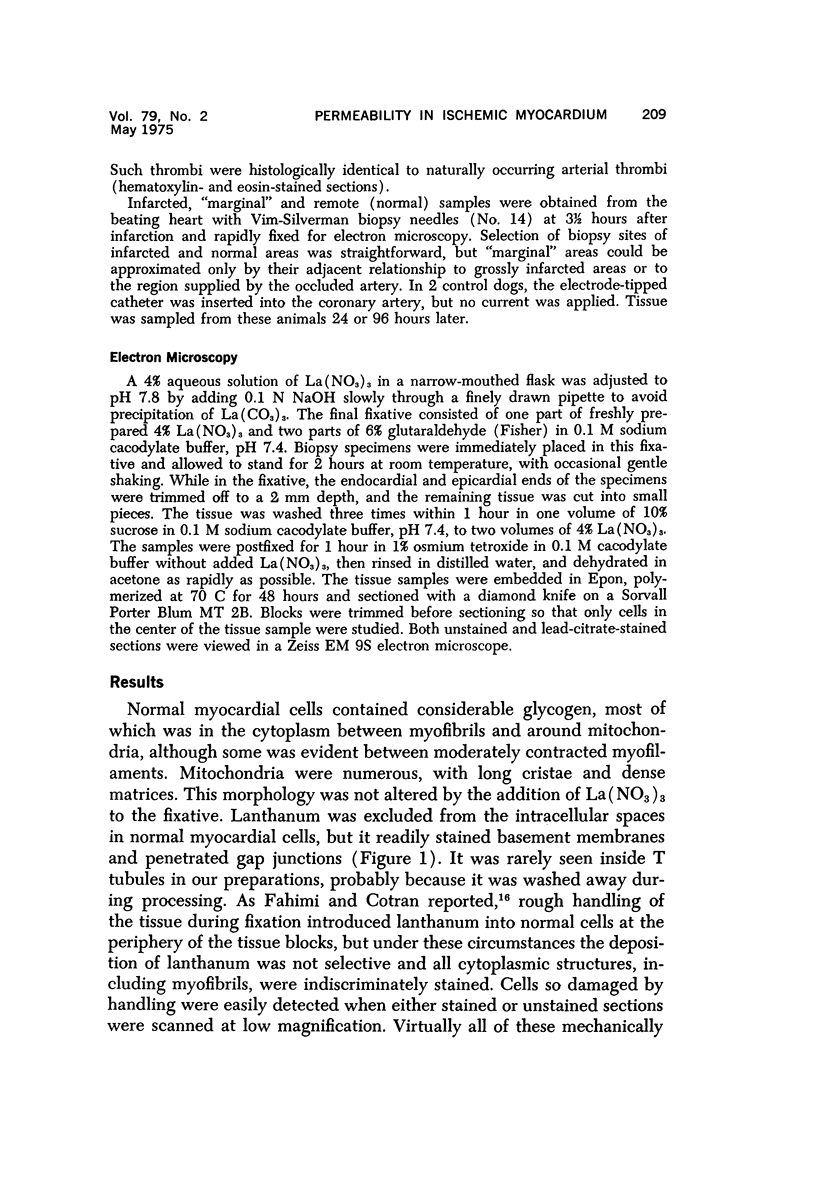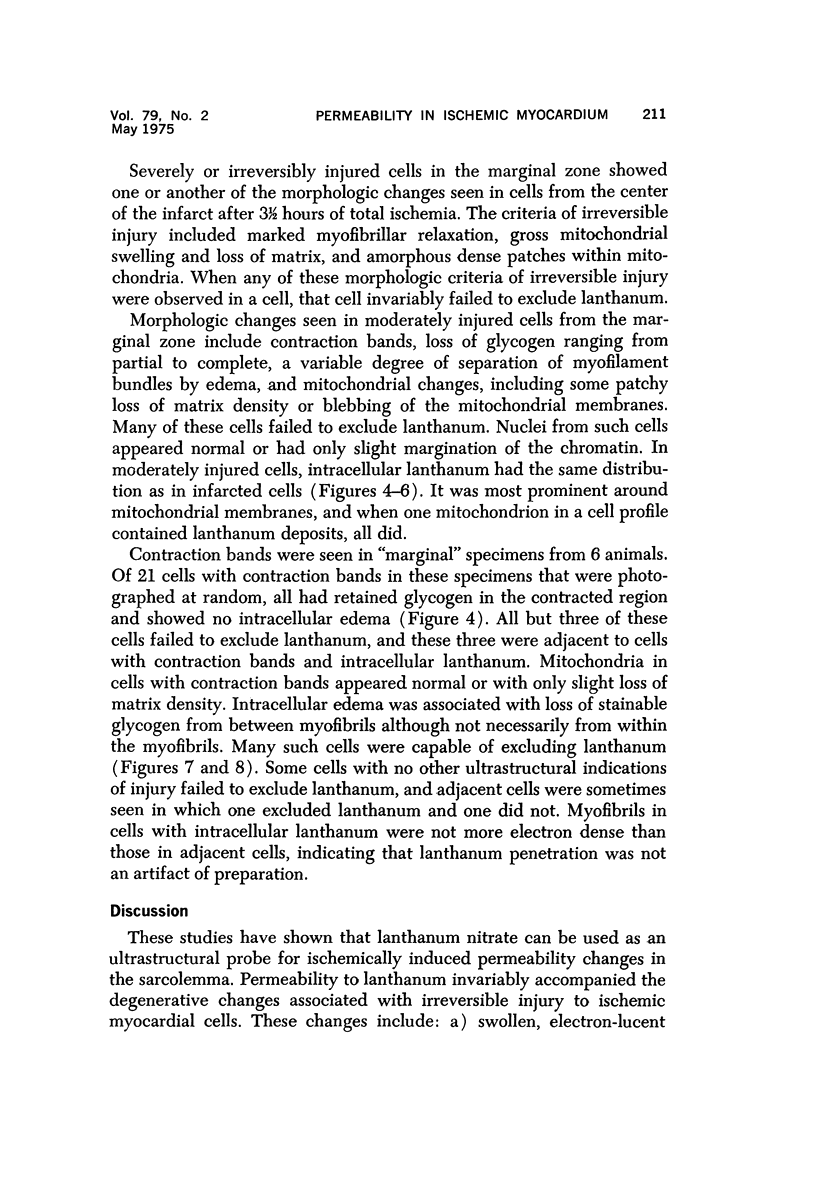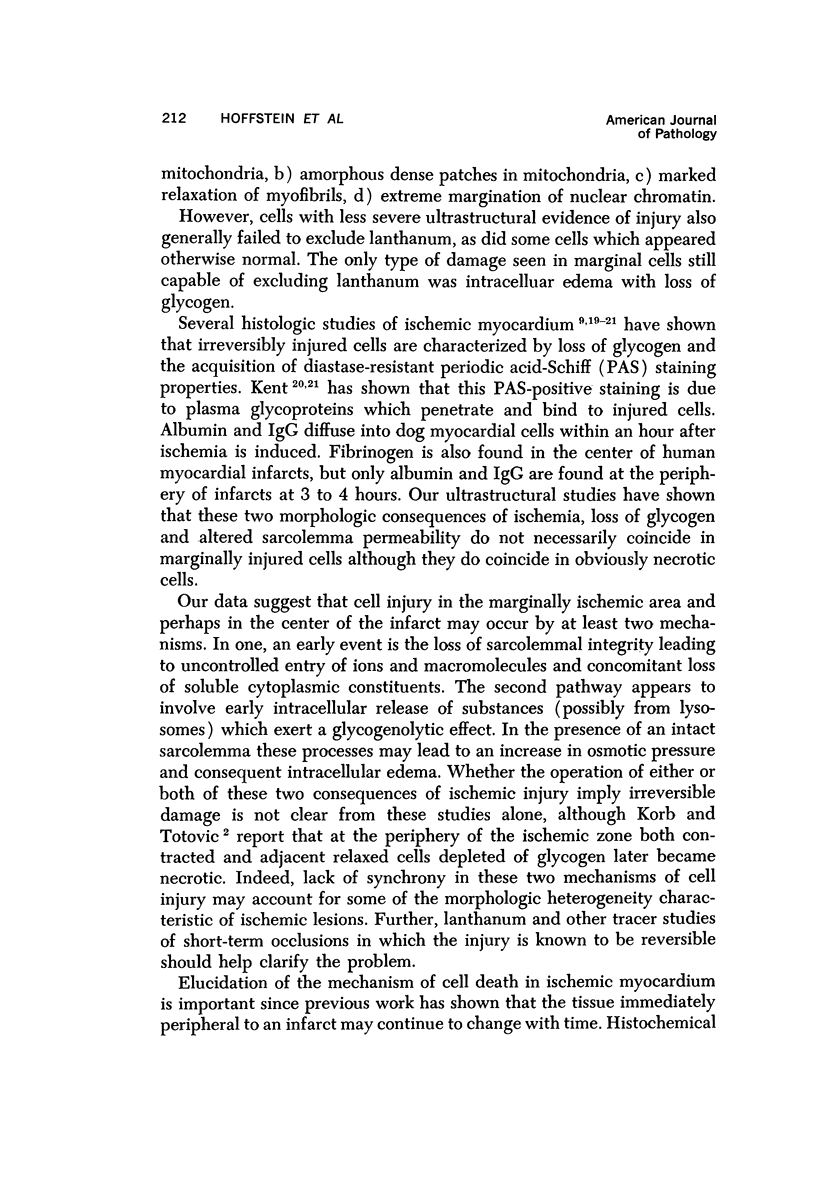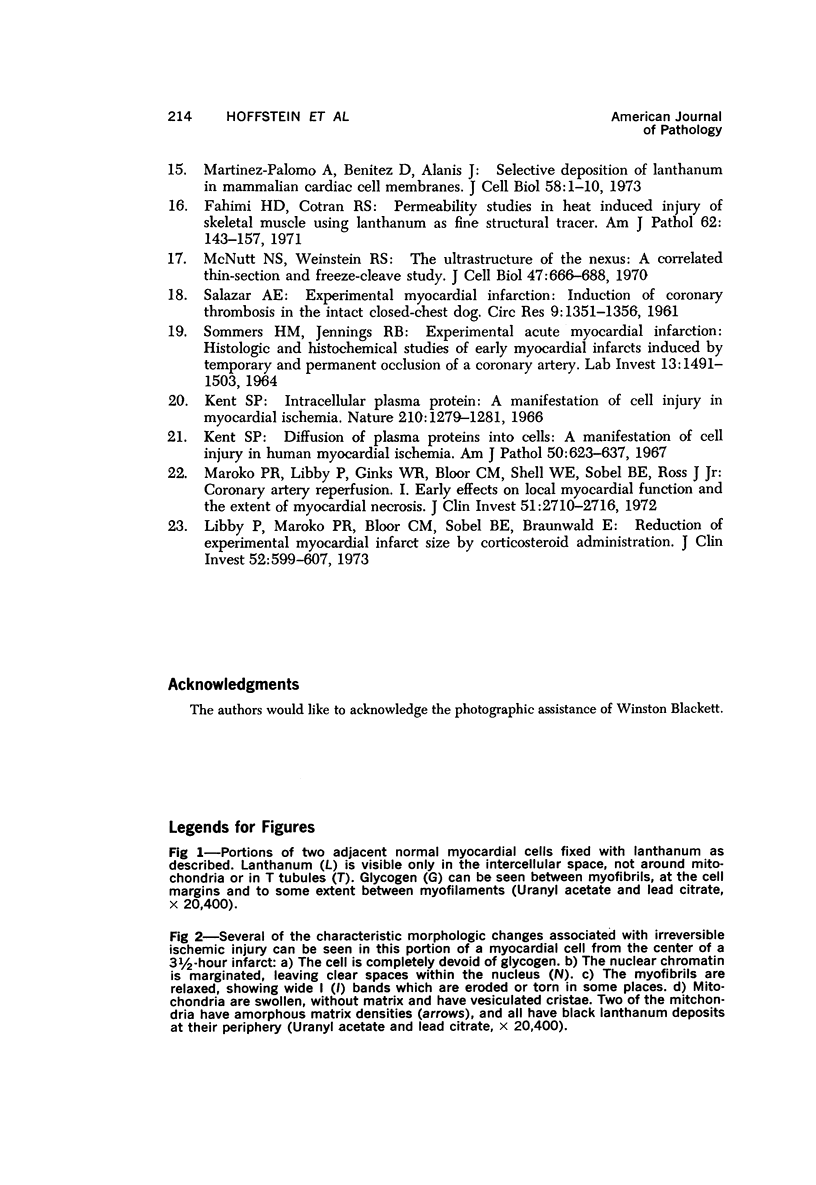Abstract
Colloidal lanthanum salts have an average particle size of 40 degrees A; consequently, this electron-opaque marker remains extracellular and does not cross the intact plasma membrane. The affinity of lanthanum for calcium-binding sites on mitochondrial membranes makes it possible to demonstrate loss of plasma membrane integrity at the cellular level in ischemic myocardium. Biopsies were obtained from infarcted, marginal and normal areas 3 1/2 hours after ischemia was produced in 9 anesthetized closed-chest dogs by electrically induced thrombosis of the left anterior descending coronary artery. The tissue was immediately fixed in 4% glutaraldehyde and 0.1 M cacodylate buffer containing 1.3% La(NO3)3, pH 7.4, for 2 hours. In normal control tissue prepared this way the lanthanum tracer, as expected, was confirmed to the extracellular spaces, including, basement membranes, gap junctions and portions of the intercalated discs. Specimens taken near the center of frank infarctions all contained intracellular as well as extracellular lanthanum. Intracellular lanthanum could be seen evenly distributed around lipid droplets and in focal deposits around mitochondria. Only when mitochondria were disrupted did lanthanum gain access to internal sites on mitochondrial membranes. Areas marginal to the infarct contained cells in varying stages of degeneration including many that appeared normal by morphologic criteria alone. Intracellular lanthanum was present in many but not all of the marginal cells in which degenerative changes could be seen. Similarly a few of the cells that appeared morphologically normal contained intracellular lanthanum. The entry of lanthanum into some of these marginal cells and its exclusion from adjacent cells demonstrated that ischemic injury affects the permeability properties of the plasma membrane and independently of other intracellular morphologic changes and that lanthanum can be a sensitive indicator of such alteration in membrane permeability.
Full text
PDF











Images in this article
Selected References
These references are in PubMed. This may not be the complete list of references from this article.
- Cox J. L., McLaughlin V. W., Flowers N. C., Horan L. G. The ischemic zone surrounding acute myocardial infarction. Its morphology as detected by dehydrogenase staining. Am Heart J. 1968 Nov;76(5):650–659. doi: 10.1016/0002-8703(68)90164-6. [DOI] [PubMed] [Google Scholar]
- DOGGENWEILER C. F., FRENK S. STAINING PROPERTIES OF LANTHANUM ON CELL MEMBRANES. Proc Natl Acad Sci U S A. 1965 Feb;53:425–430. doi: 10.1073/pnas.53.2.425. [DOI] [PMC free article] [PubMed] [Google Scholar]
- Dusek J., Rona G., Kahn D. S. Healing process in the marginal zone of an experimental myocardial infarct. Findings in the surviving cardiac muscle cells. Am J Pathol. 1971 Mar;62(3):321–338. [PMC free article] [PubMed] [Google Scholar]
- Fahimi H. D., Cotran R. S. Permeability studies in heat-induced injury of skeletal muscle using lanthanum as fine structural tracer. Am J Pathol. 1971 Jan;62(1):143–157. [PMC free article] [PubMed] [Google Scholar]
- HERDSON P. B., SOMMERS H. M., JENNINGS R. B. A COMPARATIVE STUDY OF THE FINE STRUCTURE OF NORMAL AND ISCHEMIC DOG MYOCARDIUM WITH SPECIAL REFERENCE TO EARLY CHANGES FOLLOWING TEMPORARY OCCLUSION OF A CORONARY ARTERY. Am J Pathol. 1965 Mar;46:367–386. [PMC free article] [PubMed] [Google Scholar]
- Heggtveit H. A. Morphological alterations in the ischaemic heart. Cardiology. 1971;56(1):284–290. doi: 10.1159/000169372. [DOI] [PubMed] [Google Scholar]
- JENNINGS R. B., BAUM J. H., HERDSON P. B. FINE STRUCTURAL CHANGES IN MYOCARDIAL ISCHEMIC INJURY. Arch Pathol. 1965 Feb;79:135–143. [PubMed] [Google Scholar]
- Jennings R. B., Sommers H. M., Herdson P. B., Kaltenbach J. P. Ischemic injury of myocardium. Ann N Y Acad Sci. 1969 Jan 31;156(1):61–78. doi: 10.1111/j.1749-6632.1969.tb16718.x. [DOI] [PubMed] [Google Scholar]
- KING D. W., PAULSON S. R., PUCKETT N. L., KREBS A. T. Cell death. IV. The effect of injury on the entrance of vital dye in Ehrlich tumor cells. Am J Pathol. 1959 Sep-Oct;35:1067–1079. [PMC free article] [PubMed] [Google Scholar]
- Kent S. P. Diffusion of plasma proteins into cells: a manifestation of cell injury in human myocardial ischemia. Am J Pathol. 1967 Apr;50(4):623–637. [PMC free article] [PubMed] [Google Scholar]
- Kent S. P. Intracellular plasma protein: a manifestation of cell injury in myocardial ischemia. Nature. 1966 Jun 18;210(5042):1279–1281. doi: 10.1038/2101279b0. [DOI] [PubMed] [Google Scholar]
- Kloner R. A., Ganote C. E., Whalen D. A., Jr, Jennings R. B. Effect of a transient period of ischemia on myocardial cells. II. Fine structure during the first few minutes of reflow. Am J Pathol. 1974 Mar;74(3):399–422. [PMC free article] [PubMed] [Google Scholar]
- Korb G., Totović V. Electron microscopical studies on experimental ischemic lesions of the heart. Ann N Y Acad Sci. 1969 Jan 31;156(1):48–60. doi: 10.1111/j.1749-6632.1969.tb16717.x. [DOI] [PubMed] [Google Scholar]
- Libby P., Maroko P. R., Bloor C. M., Sobel B. E., Braunwald E. Reduction of experimental myocardial infarct size by corticosteroid administration. J Clin Invest. 1973 Mar;52(3):599–607. doi: 10.1172/JCI107221. [DOI] [PMC free article] [PubMed] [Google Scholar]
- Maroko P. R., Libby P., Ginks W. R., Bloor C. M., Shell W. E., Sobel B. E., Ross J., Jr Coronary artery reperfusion. I. Early effects on local myocardial function and the extent of myocardial necrosis. J Clin Invest. 1972 Oct;51(10):2710–2716. doi: 10.1172/JCI107090. [DOI] [PMC free article] [PubMed] [Google Scholar]
- Martinez-Palomo A., Benitez D., Alanis J. Selective deposition of lanthanum in mammalian cardiac cell membranes. Ultrastructural and electrophysiological evidence. J Cell Biol. 1973 Jul;58(1):1–10. doi: 10.1083/jcb.58.1.1. [DOI] [PMC free article] [PubMed] [Google Scholar]
- McNutt N. S., Weinstein R. S. The ultrastructure of the nexus. A correlated thin-section and freeze-cleave study. J Cell Biol. 1970 Dec;47(3):666–688. doi: 10.1083/jcb.47.3.666. [DOI] [PMC free article] [PubMed] [Google Scholar]
- Revel J. P., Karnovsky M. J. Hexagonal array of subunits in intercellular junctions of the mouse heart and liver. J Cell Biol. 1967 Jun;33(3):C7–C12. doi: 10.1083/jcb.33.3.c7. [DOI] [PMC free article] [PubMed] [Google Scholar]
- SALAZAR A. E. Experimental myocardial infarction. Induction of coronary thrombosis in the intact closed-chest dog. Circ Res. 1961 Nov;9:1351–1356. doi: 10.1161/01.res.9.6.1351. [DOI] [PubMed] [Google Scholar]
- SHNITKA T. K., NACHLAS M. M. Histochemical alterations in ischemic heart muscle and early myocardial infarction. Am J Pathol. 1963 May;42:507–527. [PMC free article] [PubMed] [Google Scholar]
- SOMMERS H. M., JENNINGS R. B. EXPERIMENTAL ACUTE MYOCARDIAL INFARCTION; HISTOLOGIC AND HISTOCHEMICAL STUDIES OF EARLY MYOCARDIAL INFARCTS INDUCED BY TEMPORARY OR PERMANENT OCCLUSION OF A CORONARY ARTERY. Lab Invest. 1964 Dec;13:1491–1503. [PubMed] [Google Scholar]
- Zacks S. I., Saito A. Direct connections between the T system and the subneural apparatus in mouse neuromuscular junctions demonstrated by lanthanum. J Histochem Cytochem. 1970 Apr;18(4):302–304. doi: 10.1177/18.4.302. [DOI] [PubMed] [Google Scholar]










